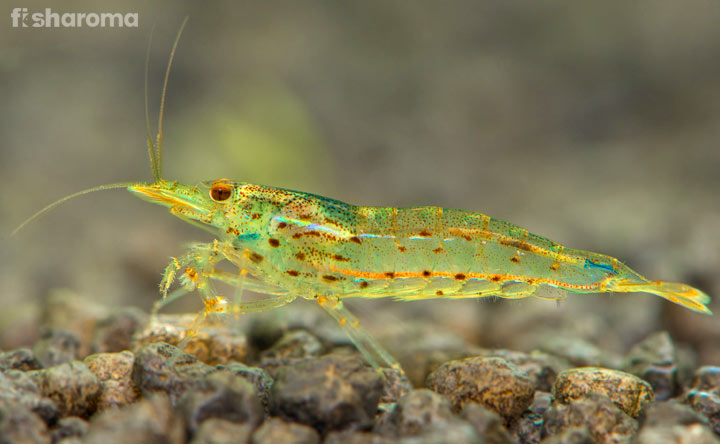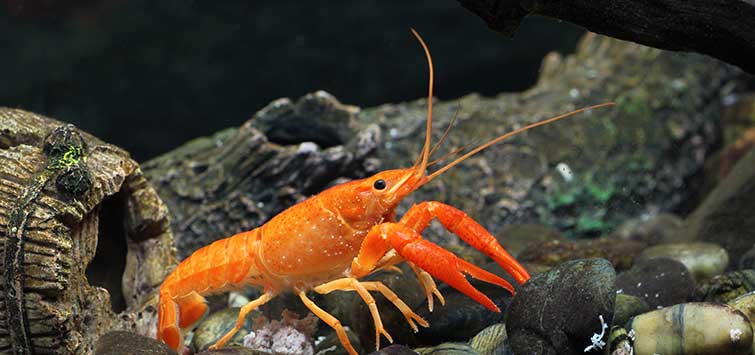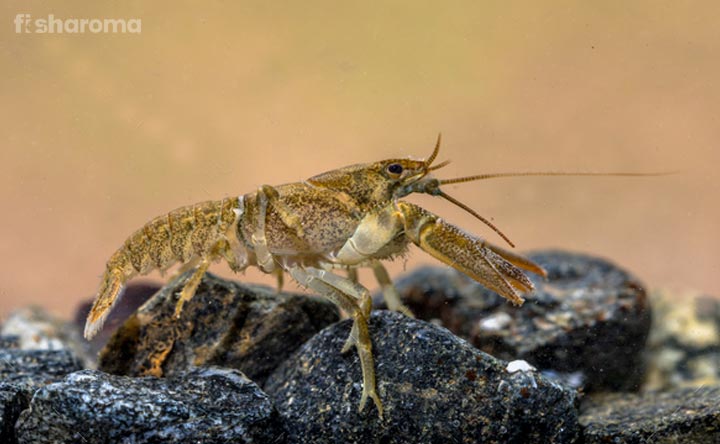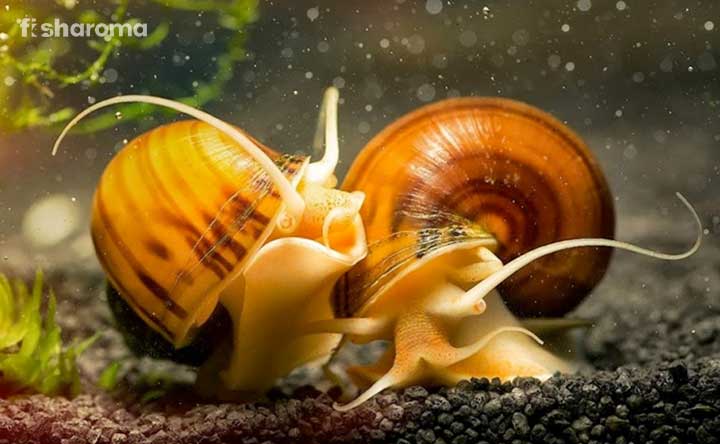Amano Shrimp – A Care Guide for This Mystique Beauty

Although an aquarium mainly houses fish, it is always great to spice things up with the addition of non-fish species. Not only it adds diversity to the tank and reflects the natural aquatic world, but it also elevates its aesthetic beauty. Besides, a lot of the non-fish aquarium pets brings along with themselves various benefits that not only are essential for ensuring the healthy life of the fish, but also for maintaining a proper ecological balance inside the tank. One such species among them is the magnificent Amano Shrimp.
A beautiful creature to look at, these crustaceans are natural cleaners. And this is going to be your one-stop point to know everything about this mystique beauty. So, without much ado, let’s get straight into it.
Key Specifications of Amano Shrimp
Before we get into the intricate details about Amano Shrimp’s appearance, origin, behavior, diet, lifespan, compatibility, tank requirements, breeding, among others, take a quick look at the key specification of this creature here.
| Scientific Name | Caridina multidentata |
| Family | Atyidae |
| Origin | Southeast Asia |
| Size | 2” (5 cm) |
| Color | Transparent to Greyish |
| Care Level | Easy |
| Lifespan | 2-3 Years |
| Temperament | Calm |
| Compatibility | High |
| Tank Size | 10 Gallons (37 liters) |
| Diet | Omnivore |
Overview
Belonging to the Atyidae family, Amano Shrimp is a freshwater species of shrimp. They are regarded as natural cleaners since they consume the algae that are found in your aquarium.
Pretty easy to pet because of their easy temperament, these shrimps are also known as Algae Shrimp, Japanese Shrimp, and Yamato Shrimp. Their fascinating appearance makes them an absolute delight to watch in the aquatic setting of your home.
Origin & Habitat of Amano Shrimp
Native to the South-east Asian countries of Japan, Korea, and Taiwan, Amano Shrimp can be found in the streams and rivers flowing from mountains into seas and oceans. They can also be seen in marshes and swamps. Although a freshwater species, seawater plays a crucial role in their life.
Amano shrimp are found in freshwater only in their adulthood because the hatching of shrimp larvae takes place in the sea where they feed on sea plankton. After growing to a desirable stage, they go to the freshwater rivers. This is the reason why breeding of this species is extremely difficult; more of which will be discussed later in this article.
Amano Shrimp was introduced to the world of pisciculture by Japanese aquarist Takashi Amano in the 1980s through his attempt to control the growth of algae in planted tanks. After encountering its’ amazing algae-eating skill, he ordered thousands and thousands of these shrimps from the local sellers. Soon, news of its biological control of algae spread worldwide and its popularity rose multi-fold. In fact, as a tribute, the species was named after him only.
The species, which was first discovered in 1892, was called Caridina Japonica until 2006 when it was discovered that this species and another species named Caridina multidentata (discovered in 1892) are one and the same kind. Its scientific name was then changed to Caridina multidentata.
Appearance of Amano Shrimp
Amano Shrimps have antennas that grow outward from the sides of their heads, just below their eyes. There are also two other pairs of antennae that grow forward from the front of their heads in front of their eyes. Their legs are attached to the underside of their carapace section.
The abdominal section is at the back of the carapace. A white stripe runs on its back from its head to tail. The Uropod, as in their tail, is translucent in appearance and it is comprised of a thin shell, on the edges of which, are fine hair-like filaments.
Size of Amano Shrimp
In case of Amano Shrimps, the females are larger than their male counterparts. While the males grow to a length of 1.5” (3-4 cm), the females grow about 2” (5-6 cm).
Color of Amano Shrimp
Amano Shrimps have a transparent body with small red cinnamon-esque spots on it. However, this little crustacean is able to change the color of its body based on its diet. To elaborate, if you feed algae to this shrimp, their body will have a greenish texture while if you feed it fish food, its body will have a reddish tint to it.
Behavior of Amano Shrimp
Amano Shrimps are peaceful and adaptable in nature, yet they are relentless, spending the majority of their time being a busy-body moving from one place to another. In addition, they are brilliant at camouflaging. In fact, it is said that if an Amano Shrimp doesn’t want to be seen, it will not be seen.
Another fascinating feature of an Amano Shrimp community is their ‘pecking order’. Now, although they are peaceful, they become frantic when food comes out and it is generally the largest shrimp that will have the first bite, following the second largest and so on.
They can also be seen foraging amongst the aquarium plants and substrate for debris and leftover food.
Many times, it has happened with aquarists that they drained the water of their tank thinking the shrimps have died only for them to discover later that they were hidden safe and sound at the bottom of the tank.
If you want to find hidden shrimps in your tank, direct flashlight onto the bottom of the tank at night. The eyes of Amano Shrimp will shine brightly and reflect back the light. However, don’t do it frequently since it might stress them out.
Lifespan of Amano Shrimp
The average lifespan of an Amano Shrimp is 2-3 years, however, it has been seen that most shrimps die soon after you add them to a tank. This is primarily because of the stress they undergo while getting transported from the place they were bought from or a change in water parameters.
It is said that with adequate food, proper water conditions and absence of predators, these shrimps live up to their full potential. They reach their maturity in 3-5 months from their birth. Although reports of these shrimps living up to six years of age have been reported, these are extremely rare.
In the event an Amano Shrimp dies in your aquarium, you will notice it turning orange and other shrimps and snails, if you have them in your aquarium, will start feeding onto it in order to ingest its minerals. Once they are done feeding, it is advised to remove the dead body from the tank so as to avoid ammonia spikes.
Diet of Amano Shrimp
Now, we have already stated that Amano Shrimps are excellent algae eaters. But contrary to popular belief, that is not what they only eat. Being unaware of this simple fact leads to the death of many Amano Shrimps in their tank.
They are omnivore in nature, which means they survive both on meat and plant matter in the wild. So naturally, a diet reflecting similar feature will only do them good. They need their diet supplementing from time to time. Obviously, the more debris and algae there are in the tank, the fewer supplements it would need. In this context, it is also advised to avoid keeping them in “too clean” tank since that would cut off their natural food source, which is, algae.
In planted tanks, they will consume the edible matters shed by the plants. They also eat dead plant matter, dead fish and other dead species left in the tank.
Try to include the following food in the dietary plan for the Amano Shrimps in your tank:
- Shrimp pellets
- Fish pellets
- Raw green zucchini
- Fish food flakes
- Blanched spinach
- Blanched cucumber
- Broccoli
- Squash
- Sinking pellets
- Frozen Bloodworms
- Frozen Brine Shrimp
- Algae Wafers
- Dried pellets
Apart from the aforementioned vegetables, you can also feed them a blanched form of other vegetables. When feeding them dried food, makes sure you wet them beforehand so as not to choke the shrimps. In case of frozen food, de-frosting the food and bringing it back to room temperature is of utmost necessity.
Coming back to algae, Amano Shrimps consume virtually all types of algae including Green Algae, Brush Algae, String Algae, and Hair Algae. The only algae they struggle with eating are Black Beard Algae and Spot Algae.
Make sure that you avoid anything related to copper or copper-sulfate in your tank since it is toxic to most invertebrates including Amano Shrimp. Also, check if the medication and fish food that you are providing them don’t have any copper content in them.
Tank Requirements for Amano Shrimp
In order to emulate its natural habitat, there are certain things that you need to keep in mind while building the tank for an Amano Shrimp. The following points will serve you as a guideline in the same:
Tank Size
The most vital point while buying a tank is its size. Now, shrimps are small beings, but Amano Shrimps are comparatively larger than other types of Dwarf Shrimps. So, if not huge, you need a moderate size tank for them. Ideally, a 10 gallon (37 liters) tank works fine Amano Shrimps.
In a 10 gallon tank, you can keep up to five Amano Shrimps, which essentially means you can keep one Amano Shrimps per two gallons of water, which is the rule of thumb you must follow. Not to forget, the number of other species and plant also do play a factor here.
Nature of Lighting
One of the natural food sources for a young fry is Diatoms present in the water column. Diatoms grow at a much faster rate in the presence of light, which is a reason to keep light sources in your aquarium.
Generally, standard community light tank is more than enough for Amano Shrimps. Light also plays an essential role in the after-care period of breeding. Since the larvae of Amano Shrimp have positive phototaxis, you can shift them from one place to another by guiding them through a flashlight.
Tank Lid
It is always better to use a lid for your tank, not only for preventing the species in your tank from jumping out of the water (although Amano Shrimps aren’t particularly known for jumping off the aquarium fence) but also to save it from other types of contamination and dust accumulation.
Besides, it will also save the shrimps from any pet cats and dogs and curious children, if you have any.
Filter
Amano Shrimps are equipped at handling water currents. Therefore, you can use a hang-on-back filter in your tank. It also reflects a similar environment to its natural habitat.
Sponge filter and moss balls catch bits of edible materials. This is why Amano Shrimps are fond of them since they can pick off food from them.
Ornaments
As we have mentioned earlier, Amano Shrimps love hiding. Therefore, try to add certain ornaments like caves and rocks that can serve as hiding spots for them. While doing so, try to not include any sharp objects that might tear off the shells of these magnificent crustaceans.
Presence of Flora
Amano Shrimps require a planted environment to thrive. Not only do they serve as good hiding spots for them, but they also are a natural food source for them since dead plant matter that gets accumulated at the bottom of the tank are an absolute treat for these shrimps.
The importance of flora gets highlighted even more when they go through molting, which usually takes place once a month. Molting is the process of an animal to shed their feathers, skins or hair in order for new growth. During molting, due to losing their shells, these shrimps feel vulnerable and prefer not to be disturbed. This is where these plants come to their aid by serving as hiding spots for them. Keep the shells that are shed by the shrimps in the tank for a day or two because it becomes part of their food which helps them re-ingest the minerals they need to get prepared for the next molting cycle.
Recommended plants to be kept alongside an Amano Shrimp are Riccardia Chamedryfolia, Egeria Densa, Cladophora, Monosolenium Tenerum, Java Moss, among others. Contrary to popular belief, there is little to no evidence that they damage aquatic plants.
Cleaning Method
As in with most other aquariums, you should never use any soap-based or other similar harsh products to clean the tank. The chemical residues that are left behind by these cleaning agents are harmful to the health of the Amano Shrimps.
Simply use warm water to clean the aquatic caves and rocks and use a piece of cloth to wipe off the interiors of the walls. Also, make sure to trim the edges of the aquatic plants from time to time.
Let us now try to understand what type of water you need to provide in the tank that houses Amano Shrimp.
Water Type for Amano Shrimp
Amano Shrimps are pretty adaptable when it comes to water conditions. Still, try to keep the following things in mind to make sure the Amano Shrimps in your tank grow healthily.
Temperature
The perfect temperature range for an Amano Shrimp is 70-80° F (22-26° C). Warm water helps boost the metabolism and increases the activity of these shrimps, which, in turn, help in algae reduction. Keep a submerged thermometer in your tank to monitor the temperature.
pH Level
The recommended pH level for the water inside a tank that houses Amano Shrimp should be 6.5-7.5, which is in the neutral zone. Generally, densely planted aquariums have a pH level in this range, which contributes to the healthy life of this shrimp. Check the pH level of the water on a weekly basis with the help of pH testing kits.
Mineral Level
Amano Shrimps are unable to handle nitrite and ammonia spikes. Therefore, the levels of nitrite and ammonia should be 0 ppm. Coming to the amount of nitrate, its level should be less than 20 ppm. Aquatic plants help in reducing the level of nitrates in the tank water.
Hardness
The general hardness of the water should be 7-8 dGH while the carbonate hardness should be 2-4 dKH.
TDS
The optimum level of TDS (Total Dissolved Solids) of the water in the tank should be 150-200 ppm.
Replacement Procedure
Although Amano Shrimps prefer a bit of unclean water that can house algae, it doesn’t mean that you will put an end to replacing the water in your tank completely. Try to replace 60% of the water on a weekly basis. Changing the entire water content will dramatically change up the temperature, pH level, mineral level, hardness and TDS of the water, which may put the shrimps into a state of shock.
The new batch of water that you add to the tank should meet the same parameters as that of the old batch.
Compatibility of Amano Shrimp
Amano Shrimps are peaceful and non-defensive in nature. Ideally, small to mid-sized, peaceful, community fish and other species of similar feature, make up great companions for Amano Shrimps.
Avoid keeping Amano Shrimp with a species in whose mouth it can easily fit into. It is also advised to avoid fish that are known for nipping.
These shrimps should preferably be kept in a group of at least six together because they function well as a community and it helps lower their stress and shyness. Their small bio-load is also an added benefit in this regard.
You may find them occasionally practicing dominance over each other, especially the larger ones when it comes to food; but it is more or less, pretty harmless. Just make sure there is adequate food for each shrimp. And yes, try to keep the number of male and female shrimps equal.
Suitable Tankmates for Amano Shrimp
The following species are compatible with Amano Shrimp and can be kept together with them without a single thing to worry:
- Cherry Shrimp
- Ghost Shrimp
- Bamboo Shrimp
- Vampire Shrimp
- Otocinclus Catfish
- Discus
- Cory Catfish
- Neon Tetras
- Guppy
- Danio
- Tiger Barb
- Bristlenose Pleco
- Hillstream Loach
- Nerite Snail
- Rabbit Snail
- Ramshorn Snail
- Mystery Apple Snail
- Malaysian Trumpet Snail
Unsuitable Tankmates for Amano Shrimp
Try and avoid keeping the following species in the same tank that houses an Amano Shrimp.
- Arowana
- Crayfish
- Cichlids
- Oscars
- Pacu
- Goldfish
- Gourami
- Betta
- Large Pleco
- Tangerine Lobster
- Cobalt Blue Lobster
Breeding of Amano Shrimp
So far, we are sure that the aforementioned attributes and requirements for keeping an Amano Shrimp at home have been quite easy for you. Well, the same can’t be said about its breeding.
Breeding of Amano Shrimp is difficult because the eggs are released in brackish water (a combination of saltwater and freshwater) and the young fry spend a considerable part of their infancy there before coming to freshwater.
In the wild, the male fertilizes the eggs and the female carries them for around six weeks, during which they keep on supplying oxygen to the eggs. After the six-week period, the females release the larvae into brackish water since salinity is required for them to develop. As they grow, they return to freshwater.
Mind you, adult shrimps are extremely sensitive to saltwater and can have hazardous consequences when they come into contact with saline water. So, as you can understand, breeding is extremely complex in these shrimps, which is why most hobbyists buy them directly from pet stores.
Difficulties in Petting Amano Shrimp
Amano Shrimps, as we have come to realize, won’t require much effort from your end for them to grow. The only struggle (which mind we say, is a huge challenge which is regarded next to impossible) lies in its breeding process.
Compatible with a wide range of species, they will give you lots of options to play around with when selecting its tankmates. Before you add them to your tank, be sure to acclimatize them to the tank water.
Beware of imposters and lookalikes, as there are several of them in the market. Look, there are over 200 varieties of Caridina, many of which look similar to each other, which makes it identifying Caridina multidentata (Amano Shrimp) all the more difficult. The easiest way to identify them is to see how active they are. Amano Shrimps are relentless and more active than other shrimps. Generally, you won’t find them lazing around in a tank.
Interesting Facts about Amano Shrimp
- The scientific name of Amano Shrimp was changed from Caridina Japonica to Caridina multidentata in 2006.
- Female Amano Shrimps have a saddle underneath their belly that acts as an egg pouch.
- Male Amano Shrimps have a row of discreet round dots on their exoskeleton while the females have stretched out dots that resemble broken dotted lines that are red, brown, green or blue in color.
- These shrimps are known to regenerate their limbs if they are lost during an injury.
Summary
Amano Shrimp is a perfect addition for your tank if you are looking for an unconventional pet which is not only aesthetically pleasing but beneficial to the tank too. Their algae eating skill makes them an apt choice for those who worry about their tank suffering from an algae attack.
Their hardy nature makes them an apt choice for beginners who don’t have much experience with invertebrates. Besides, they are compatible with a wide range of species barring few large, aggressive ones. So everything considered, feel free to include them in your aquarium and let them clean your tank like it’s no one’s business.
Sneak-Peek of Other Unique Aquarium Creatures
Take a sneak-peek into the care guide of other unique aquarium pets.
- Moray Eel: For those daring fish enthusiasts, here is the care guide of one of the most unconventional pets for an aquarium – the Moray Eel. Check out its details here.
- Pipefish: Want to elevate the aesthetics of your aquarium by the inclusion of a distinct pet? If your answer is yes and if you are ready to put in some effort, Pipefish is what you need. We provide its care guide here.
- Garibaldi: Add a dash of orange in your aquaspace by bringing home a Garibaldi. Semi-aggressive and territorial in nature, they elevate the beauty of your tank by multi-fold. Learn their care guide from this space.









